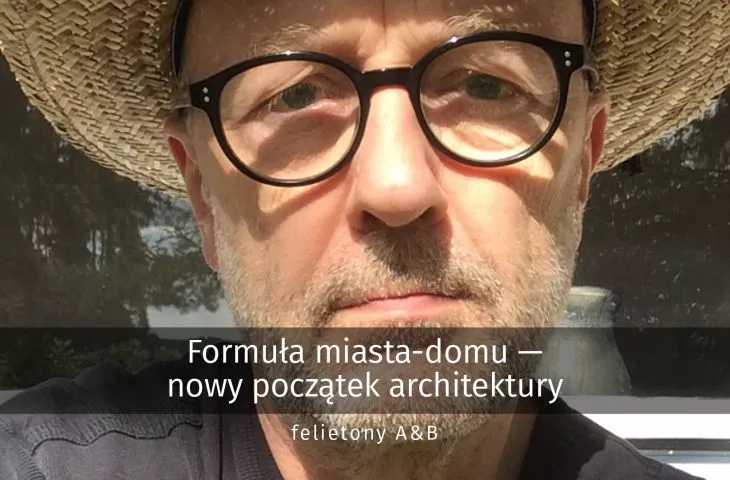The city-home formula
- a new beginning for architecture
[ A&B 12'2019 original material]
This story often comes back to me and continues to take on new meanings. Here I was once renting a house among the narrow streets of the old city of Queretaro. I was driven to it from the airport in Mexico City by a university driver in a university (as it is in Mexico) hunchback....
After three hours we stopped in front of a house on Melchor Ocampo Street. The architect who offered me the rental was waiting for us on the narrow sidewalk. After saying hello, when he was already extending a hand with a key in my direction, he suddenly stopped it and withdrew it.
- Before you move in here, you should know that this is the only house in Queretaro with four original Noguchi lamps.
- This is the best invitation I could have imagined.
Now the key reached my hand. Innes watched my movements. In the darkness of the street in the middle of the black-painted iron double doors I spotted a copper-colored padlock. I slid the key in. The lock gave way with a click. I removed the padlock and grabbed the handle.
- Be careful, there are two steps behind the door.
The right wing squeaked, I carefully went down. I was in the living room: a large work table across from me, further to the left a low coffee table, sofas, equally low bookshelves and - yes, yes - four floor-to-ceiling tall, paper-burning Noguchi lamps set in the four corners of the room.
- Hey Innes, thanks for such an atmosphere....
- You welcome, Jacek. Have a great time here.
The driver was already tired, Innes hurried home. We said our goodbyes. The suitcase stood just behind the stairs. I moved the black door bolt, it slammed metal against metal. I was left alone.
On the wall separating the living room from the street quite a distance from the door was still a window, barred in Spanish. In the opposite wall, on the other side of the living room, between a table and a coffee table, was a wide passage to the next room. Here there was no door, and the clay wall that separated these rooms was nearly a meter thick. Beyond the passage, the ceiling was already lower. On the left, as if sunk into the wall, was a wooden closet, and on the right stood only a sizable bed. On the axis of the passage through the thick wall, in the next wall was the second already double iron door. They were open, and behind them, probably seven centimeters below, was a small patio that filled with seven centimeters of water in the rainy season. To his right - an alcove under a roof that stretched over the kitchen, then a bathroom; to his left, a door-enclosed lamppost and then a concrete laundry mold, complete with pool and tare. The patio was enclosed by a wall the same height as the adjoining rooms. Above it all was a rusty water canister.
- It's an old craftsman 's house," Innes explained the next day over breakfast at the house he and his wife had built outside the city, "This is how people used to start life in the city. They had a large work room right on the street, with a minimum of space behind it for daily living.
- I don't need anything else here. It's just too bad that the university is not two blocks away.
- The university is not, but our friendly restaurant is. Ah, but remember, don't call it a restaurant. Say: gallery. The chef who runs it says he practices the art of lunch; indeed, in the evenings he makes the room available to artists for exhibitions.
When Innes handed me the keys to his townhouse, it was January. The temperature had dropped to freezing at night, and the only heating in the entire house was the sun, which would appear at the top of the patio wall in the mornings and descend baaaay slowly toward the chairs, which were cold after a night's sleep. One day I came up with the truly urban idea that the sun must have been on the nearby plaza since dawn, as the houses surely only cover part of its urban floor. Proud of the idea-opposed-at-the-knowledge, I slammed the padlock on the door and huddled in the chill of the morning and walked to the nearest square. I was right. Except that I wasn't the only one. The square was full of residents, and the best seats on the benches were occupied by those who had made their decision the evening before sunrise.
Today I think of small houses in small cities in Europe, in Poland. How good a design, how well thought out. A small house in the center of the city that helps you earn a living and maintain the house itself. A small house that is close to the people, your potential customers. A small house that is part of all that the city gives you: friends, friendly places, restaurants, the hot morning sun in the square. Today we enjoy good transportation within the city, we love our bicycles. Or maybe we should return to the formula of a city-home, where - where! - we walk on foot, which is ours in common, in which we only inhabit a super-private living room with a workspace, with a small bedroom and a tiny patio. The city where we have a favorite restaurant full of friends, which with its coolness decides the power of the morning, the power of a new day. A city of houses that decides the new beginning of architecture.
***















